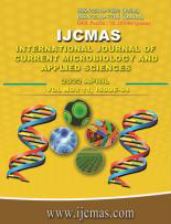


 National Academy of Agricultural Sciences (NAAS)
National Academy of Agricultural Sciences (NAAS)

|
PRINT ISSN : 2319-7692
Online ISSN : 2319-7706 Issues : 12 per year Publisher : Excellent Publishers Email : editorijcmas@gmail.com / submit@ijcmas.com Editor-in-chief: Dr.M.Prakash Index Copernicus ICV 2018: 95.39 NAAS RATING 2020: 5.38 |
Chickpea (Cicer arietinum L.) also referred to as "poor man’s meat and rich man’s vegetable" is that the second most significant food legume within the world after beans in terms of area (13.5 million hectares) and production (13.1 million tons). Variability may be a greater need for initiating a breeding program for yield and yield contributing traits. a complete of 35 lines, together with a check, were evaluated in Randomized Complete Block Design (RCBD). Highest seed yield per plant was recorded by IPC-04-01. All the traits except number of branches showed significant variation among the lines. Number of pods per plant, biological yield and number of secondary branches showed high Genotypic Coefficient of Variation (GCV) and Phenotypic Coefficient of Variation (PCV), whereas number of number of seeds per plant, number of pods per plant and days to maturity, showed moderate GCV and PCV. Supported D2 values, 35 genotypes were grouped into nine clusters. Cluster I with 4 genotypes, cluster II with 13 genotypes had highest number of genotypes, cluster III with 9 genotypes, cluster IV & V with 1 genotypes in each, cluster VI with 4, and cluster VII, VIII and IX with 1 genotype each. The non-hierarchical Euclidean cluster analysis using 13 quantitative characters revealed maximum diversity between cluster V & IX. supported cluster means, cluster distances and as such performance BGD-9977, ICC-1205, RVG-204, IPC-12-100, ICCV-16317, JG-130 were found more diverse among 35 chickpea genotypes which may well be used as parents in hybridization programme for more heterotic response and generation of higher segregants in chickpea breeding.
 |
 |
 |
 |
 |